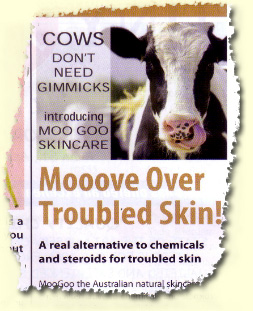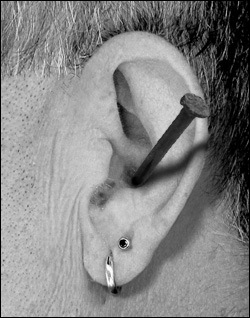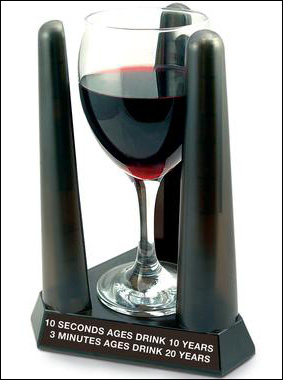When the maker of some web app or another doesn’t know how to make money out of a popular idea, the go-to concept is of course to somehow shoe-horn advertising into the user experience. Those of you who have a Facebook account will be familiar with the little panel of ads that runs down the side of the page – a little panel that seems to increase in length every time you log on. Personally, I think it’s completely daft way for an advertiser to spend their bucks – I must have ‘seen’ several thousand of those damn things displayed on my Facebook page and I hardly even notice them. Someone has convinced advertisers otherwise, though, or they wouldn’t be paying for them.
If I do notice one, though, it’s usually because it has an overly-high annoying factor. An offering that popped up this morning was a shining example. Ladeez and Gentlemen, I bring to you today…
The AMAZING TINNITUS MIRACLE™
Ah yes. Your flim-flam detectors just went ping, right. If they didn’t, get off my blog!
Now, I must confess that until this morning I didn’t really have a great deal of insight into tinnitus. Well, not of a scientific kind, anyway. I know what it is, of course, being a professional sound person & all, and I’ve even experienced it myself in my youth when I was much less careful of my hearing, but I’ve never known much about it physiologically. After reading the Tinnitus Miracle™ website, though, one thing of which I was entirely certain is that you need absolutely no knowledge of tinnitus to get the feeling that this site is designed to fleece easily-deceived and desperate folks of their money by convincing them that it has the absolute, failure-proof, 100% guaranteed cure for their affliction.
And, as a prospect for a scam – for a scam it surely is – it makes sense. Tinnitus is a medical condition with all the requirements that make it ripe for the pickings of those who would greedily make money from exploiting others: it’s a poorly understood, highly subjective condition with diffuse symptoms, and it can have dozens of causes. It’s distressing, persistent and can even be painful, but it’s not life-threatening. Best of all for the woo merchants, it’s a sad fact that science-based medicine doesn’t offer much in the way of relief for many sufferers of tinnitus. ((Something that people who advocate ‘alternative medicine’ seem not to understand this situation too well, and you’ll often hear it put forward as a criticism. Science-based medicine never pretends that it has all the answers, because sometimes it doesn’t. There are some things science doesn’t understand very well. That doesn’t make science faulty – it just means that a complex world is not easily understood all at once. It’s a process. And the fact that science doesn’t have an answer to a complex problem doesn’t lead logically to the proposition that ‘alternative’ medicine does. Having no solution to a problem sometimes means, quite harshly unfortunately, that we don’t have a solution to the problem. We simply don’t know everything, and there is no imperative says we should. That’s not an easy thing to tell someone who is in pain, or who has a chronic debilitating condition. Unfortunately, as much as we don’t like that reality, reality really doesn’t care what we like.))
Even though I did go on to spend a little time reading about the condition, you really don’t need a lot in the way actual knowledge to get a strong sense that the Tinnitus Miracle™ ‘phenomenon’ ((Because that’s the way it’s promoted WIDELY across the interwebs.)) is decidedly fishy.
Skimming down the MASSIVE landing page starts the alarm bells ringing fast. ((Of course, if you have severe tinnitus, maybe the noise in your head might drown out said alarm bells. Perhaps this is what the makers of the Amazing Tinnitus Miracle are counting on…)) The amazing Tinnitus Miracle™ is an eBook that you can buy for the handy dandy price of $39, and which unequivocally offers to ‘give you the secrets to eliminate virtually all types of Tinnitus within 8 weeks.’ It’s the enterprise of one Thomas Coleman, ((Coleman may or may not be a real person. For the purposes of this post, I will accept that he is, although I did discover a number of things that made me suspect that he may be a fictional concoction.)) who purports to have suffered from tinnitus for 14 years and to ‘have tried every tinnitus treatment known to science and natural health’, including, but not limited to, ‘herbal remedies, Cellfood Oxygen, tonics, habituation, detox diets, vitamin therapy, hydrotherapy, aromatherapy, macrobiotics, reflexology, Chinese Medicine, vegetarianism, the Wai diet, magnetic therapy, the mucus-less diet, the blood type diet, psychiatric treatments and whatnot.’
The outcome is that none of these (not even ‘whatnot’) were effective. Even surgery didn’t help the poor chap, nor did ‘dietary’ advice nor white noise CDs. Eventually we learn that the unflappable Mr Coleman was cured after discovering ‘a simple holistic system [that] opened the door to my new and much brighter Tinnitus free life.’ The site spares no effort to attempt to impress upon us exactly what a MIRACLE this discovery was. There’s the familiar liberal use of exclamation marks, copious underscoring, oodles of hyperbolic claims, excitable slashes of yellow highlighter and then… THE SCIENCE. Well, no, I lied. There’s no science. None. Nada. Nuttin’. What we have is that ol’ reliable science substitute though: testimonials! Everyone KNOWS a testimonial is MUCH better than science. Let me show you how it works:
♥Tetherd Cow Ahead is the best blog in the universe, bar none. I read it once and it completely cured my cancer! ~ Landon from Illinois
♥I used to have trouble keeping it up, but thanks to Tetherd Cow Ahead I can now go all night! Tetherd Cow rocks! ~ Raymundo
♥I purchased the Tetherd Cow Virtual Glass of Water and I’ve never had a computer virus since! Awesome work TCA! ~ Kofi Anan
Now brace yourselves, Acowlytes: those are not real endorsements, and they hold no credibility whatsoever! I just made them up! I know it seems shocking that someone should do such a thing, and I know you wouldn’t, dear friends, but the internet is, alas, not completely populated by good honest folks such as yourselves.
The point is of course that a fistful of internet testimonials is worth about as much as the paper they are printed on. Unfortunately there still exist out there a substantial number of people who seem to think that if something is written down in words, why, it must be true! Or something. It doesn’t seem to occur to them that the endorsements could easily be as phoney as the names attached to them. ((I’ve long pondered why this should be so. I mean, I totally understand how you might buy a product that was recommended to you by a close friend. I can even stretch to understanding how you might buy a product endorsed by someone who you don’t know personally, but whose opinion you respect for some reason. But I can’t for the life of me even remotely comprehend why you would trust the opinion of some anonymous (and probably fictitious) name from woop-woop!)) What’s more, it seems that such people of limited perspicacity are unable to infer that fifty fake testimonials are no more persuasive than one. I could’ve written dozens above had I been so inclined – it’s not exactly difficult to make that shit up. ((It is vaguely possible that the testimonials are written by actual people, but this doesn’t necessarily mean they are genuine. Lots of people are willing to lend their name and photo out for a fiver. And, being extremely generous, even if the people are real, and the testimonials unsolicited, it still doesn’t mean that the information in them is necessarily accurate, nor representative of most tinnitus sufferers. Tinnitus does, in many cases, clear itself up spontaneously. If you have a few thousand people reading your book, it is quite likely that a small few will have spontaneous natural remission of the symptoms, and attribute it in some way to your magical cure. You only need a handful of those kinds of ‘miracles’ to make something look impressive…))
But it’s not until you try to find some more information about Tinnitus Miracle™ that you begin to see the real depth of this racket. Performing a Search™ on the term returns a veritable truckload of spew. Hundreds, maybe thousands of links that duck and dive through the tinnitus world, inevitably making their way back to a site selling Tinnitus Miracle™.
And not even the merest hint of proper science on a single one of them.
Searching for tinnitus+miracle+scam is an even more enlightening experience. Now we see dozens of hits in the vein of this site, returning search abstracts like ‘There is no basis for the tinnitus miracle scam’ and Is Thomas Coleman’s Tinnitus Miracle Book A Scam? My Opinion … – all couched in such a manner as to appear to be a critical appraisal of the product. If you click through, though, they all go on without exception to overwhelmingly promote Tinnitus Miracle™ in some way or another, often with direct links to the main TM™ site. There are pages of these duplicitous offerings – I clicked through a few dozen and I couldn’t find one that wasn’t some kind of endorsement of Tinnitus Miracle. ((This in itself is an intriguing indictment of the Tinnitus Miracle™ It shows clearly that the people behind it are completely aware that what they are promoting has every indicator of being a scam to those searching for tinnitus relief, and have shaped their marketing strategy accordingly. They are, in essence, predicting that they will be called on their scam, and then flooding possible criticism with noise.)) In fact, try as I might, I couldn’t find any negative critique of the Tinnitus Miracle at all. Lest you think that might be because the thing actually works, let me add that I also couldn’t find a single site that looked like it was a genuine unsolicited recommendation of the product either. To my eye, these sites all look like part of the Tinnitus Miracle empire – a vast and comprehensive attempt to stake a presence wherever anyone with tinnitus might search for some help. Now, there are two reasons I can think of that negative (or even mildly critical) reviews aren’t returned high-up in the search results. The first is that Coleman’s strategy is simply to super-saturate the SEO so that other links are just pushed way down, and you won’t easily come across adverse criticism, and the second rather more sinister one is that Mr Coleman is actively litigious and has aggressively quashed any unflattering press. ((I’d like to think this is not the case, but I guess we will see if that speculation has any substance if he finds this post.))
Another frustration I had was in attempting to find out exactly what might comprise the substance of the Tinnitus Miracle. After reading pages of mind-numbing verbiage, I was concluding that the book offering the wondrous Tinnitus Miracle was probably just a mish-mash of anything and everything that might pertain to tinnitus, with not much ‘miracle’ content at all. This site (another TM™ promotion, despite its efforts to appear to be something else), supposedly penned by one ‘Britni Dorman’ gives some support to that conclusion:
Here are some things you can learn from Tinnitus Miracle:
• Eight food items that are best for you in this condition
• Ten foods you must learn to avoid like the plague since they can worsen your condition
• The name of a powerful herb used in homeopathy that can reverse the condition quickly
• The 100% natural secret vitamin supplement that can impact your condition dramatically in just a few days
• Medications that can worsen the condition
• How you can diagnose your condition with the help of a multi-dimensional approach
• Effective breathing techniques and strategies that allows your body to begin the process of healing
Ah, right. Good foods, bad foods, vitamins, homeopathy and Evil Big Pharma drugs that you can blame. Uh-huh. And some yoga & meditation thrown in for good measure (‘cos it certainly can’t hurt, right?) As miracles go, this is looking about as impressive as producing a coin from behind a kid’s ear.
There’s lots more of the same on this site, which purports to be a tinnitus ‘treatment advice’ hub, but which is revealed by even a cursory exploration to be crammed to the gills with links to the main Tinnitus Miracle site. Perhaps the most hilarious part is the the ‘Pros & Cons’ section. Breathless raving about the pros, but the cons, well:
• Cons – When it comes to the cons, I have to admit that Tinnitus Miracle barely has any.
Mr Coleman may as well have appended his signature to that one.
I did turn up one comment on a tinnitus relief discussion group from someone who seems to know what the book entails. The main thrust of this thread is another tinnitus scam called Quietus, ((Another sure marker for scams of this kind is the appearance of other players on the field. You can bet that where there’s an opportunity to bilk vulenerable people, there’ll be more than one opportunist with his finger in the pie.)) but several sufferers ask if anyone has tried the Tinnitus Miracle. Well, someone called MissionCMD has done so, and had this to say:
I have purchased the book and read it twice. I have tried numerous things in it, but there is no ‘miracle’. There are numerous sections in the book that are duplicated (copy and paste) from one chapter to another… not to mention numerous spelling mistakes. Perhaps the ‘e-book only’ option was because the author could not get a publisher to edit? Overall, there were a few good suggestions, but there was no ‘miracle cure’ if that was what you were trying to ask. Essentailly just ways to try to manage the noise. I did a detailed search for almost three hours to try to find a reputable review before I purchased anything, and could find none. I could find many websites that had supposed reviews, however it looked much like the similar advertisement off of the original site. Suprisingly (or not) none of those sites were accepting comments anymore due to spam… hmmm. I did purchase the book anyway. You do have to keep in mind it does state ‘holestic’ in the sub-title. So the book did what it said… mentioned everything under the sun you can try to manage the tinnitus. That means recommendations ranging from therapy sessions, to extreme detoxification, to accupuncture. I personally did not find anything close to a ‘miracle’ though.
And that’s about as succinct a wrap-up as you could ever expect; the Tinnitus Miracle™ eBook appears to be nothing more than a diffuse hodge-podge of vague suggestions and both conventional and speculative treatments offered as options to address an affliction with multiple possible causes and a wide range of diverse symptoms. It seems to me, in fact, that Thomas Coleman is offering the very same solutions in his book that he says he tried in vain to cure his own tinnitus, just re-heated and served with a sprig of parsley.
A miracle, not so much.
I guess some of you are saying at this stage ‘It’s not really selling anything bogus – what’s the harm here?’
Well, this is the kind of scam that irks me for numerous reasons. First and foremost, it’s targeting vulnerable miserable people and offering them a ‘miracle’, when by any reasonable reckoning that’s not what they’re going to get when they fork out their money. ‘Eliminate Your Tinnitus Within 2 Months!’ the site declares, a promise that, as far as my reading indicates, is unlikely to be fulfilled for the majority of tinnitus sufferers. Tinnitus Miracle ‘…gives you the power to Cure Tinnitus permanently’, we hear: weasel language that deftly transfers any failure to deliver a result from the product itself to a responsibility for the sufferer to be capable of harnessing the supposed ‘power’. The site is full of such duplicity.
Another tactic that I find highly questionable is Tinnitus Miracle’s liberal us of scare tactics, another staple of scamdom:
WARNING: TINNITUS CAN BE VERY DANGEROUS IF LEFT UNTREATED
Well, no, for most sufferers that’s unlikely, despite the blood red fright caps. It is completely true that tinnitus can sometimes herald other more serious problems, but one thing is for sure – buying this book is not the way you’d want to handle that particular circumstance. As with most medical problems, if the symptoms persist, the most sensible thing you can do is to promptly see your doctor (and that information I’m providing totally free of charge).
Elsewhere:
One should only consider surgery for tinnitus if you were diagnosed with a tumor, osclerosis, or fistula . Even so the success of the surgery is 50%, with the inevitable consequence of irreversible deafness.
…which is a piece of negligent generalization bordering on criminality. The success of tinnitus surgery depends entirely on the circumstances of any individual, and the reasons for their problem. To scare all people who may be facing tinnitus surgery with the spectre of the ‘inevitable consequence of irreversible deafness’ is highly irresponsible, and demonstrates clearly that Thomas Coleman cares not one whit about your wellbeing – he just wants your $39.
My reading about tinnitus over these last few days has shown me that for an unfortunate few of those afflicted, the condition is utterly debilitating, and for the greater number it is, at the very least, distressing and uncomfortable. What these people really need to be doing is consulting knowledgable health care providers and getting the best help available. What they don’t need is a whole lot of baloney about the ‘wrong’ food and homeopathy. Even if some of what the Tinnitus Miracle book offers might be helpful (there are indications that meditation, for instance, may be of some benefit to some sufferers, depending on the cause of their tinnitus) it looks like it’s wound up with a lot of crap that’s irrelevant, of arguable efficacy or just plain hogwash.
Aside from that, the marketing campaign for Tinnitus Miracle™ is plainly full of misdirection and flimflam. As a ‘Small Sample Of What You’ll Learn When You Download Your Copy Of The Tinnitus Miracleâ„¢ System Today’, the site reels off dozens of specious claims, lame observations and tips such as these:
• Discover EVERYTHING you need to know about tinnitus, EXACTLY what causes the noise in your head. [Caps are theirs]
No-one knows EXACTLY what causes tinnitus. It can be the result of several different pathologies – physical hearing damage, biochemical interaction, neurological damage or problems, or the effects of other illness. In some cases it has a psychological component. Thomas Coleman is promising to give sufferers something that no doctor on the planet can. Why on earth should anyone believe him?
• What Personality characteristics do tinnitus sufferers share?
Oh, I dunno? The same star signs? A morbid fear of hummus? This is a stupid and irrelevant question, and is so wide in its scope that you could factor just about anything in here.
• The most powerful homeopathic herb (that can quickly reverse most tinnitus conditions) that the Tinnitus and drug industries hope you will never find out!
Of course!! The ‘drug industries’ WANT you to have tinnitus because they are EVIL. Mwahahahaha!
Please. Even the dimmest of the dim can see that this is complete rubbish. If such a ‘homeopathic herb’ even existed, only one altruistic tinnitus sufferer would need to publish its name on the net and the whole world would know. BAM! Take that Evil Big Pharma Mad Scientists. But guess what? No-one has. They obviously all feel so indebted to Thomas Coleman for revealing it to them that they don’t want to see him lose any of the money he would otherwise make on his eBook!
• The cardinal sin of every tinnitus treatment almost every tinnitus sufferer is guilty of, which instead of curing your tinnitus, weakens and destroys your body’s natural ability to defend itself, thus putting your health in serious risk and making your Tinnitus worse in the long run (and more than 92% of tinnitus sufferers are doing it!)
And you thought that masturbation just made you blind!
It’s all smoke & mirrors designed to deflect anyone from asking the question: ‘But what, exactly, am I getting for my $39?’
Which is, by all indications, nothing that’s likely to help you much, and certainly nothing that can compare to the advice that you will get from a good medical practitioner. If you have tinnitus, you have my immense sympathy. Having only experienced it as a fleeting annoyance brought on by my own carelessness, I can only imagine how awful it must be as a chronic condition. I hope that this post has helped you avoid spending money on something that would probably offer you little in the way of relief.











